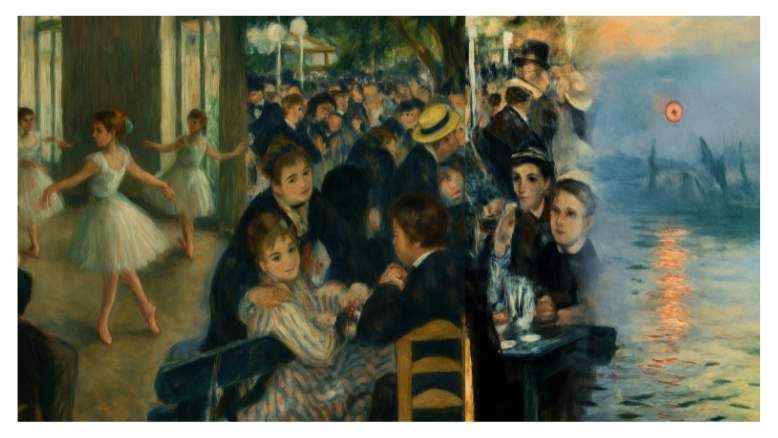Impressionism transformed the art world with its radical focus on light, colour, and fleeting moments of life. Explore its connection to Expressionism, legendary artists, and the movement’s enduring influence on modern art.
A Brushstroke That Changed Everything
In the late 19th century, a quiet revolution began on the streets of Paris—not with politics, but with paint. A group of artists defied the rigid rules of academic art, stepped out of their studios, and captured fleeting moments of everyday life using vibrant colour and loose brushwork. This movement became known as Impressionism, a term initially used in ridicule but soon embraced as a mark of artistic innovation.
Impressionism was not just a style; it was a way of seeing. It redefined the boundaries of painting by focusing on light, atmosphere, and immediate perception—a radical break from classical art’s idealised forms and historical themes.
But Impressionism wasn’t born in isolation. It grew out of shifting artistic, social, and philosophical currents and later became a bridge to movements like Expressionism, where the inner world of emotion took centre stage.
From Observation to Emotion: Impressionism’s Link to Expressionism
Though stylistically different, Impressionism and Expressionism share a fundamental aim: to transcend mere representation and evoke a deeper human experience. Where Impressionists painted the play of light on water or the haze of a Parisian morning, Expressionists twisted form and colour to reflect inner turmoil and psychological intensity. Some argue that the emotive brushwork and personal perspective of artists like Claude Monet laid the groundwork for Expressionism. Fluidity of Impressionism, its subjective capture of a moment, evolved into Expressionism’s urgent, raw portrayal of the soul. The two movements are, in a sense, emotional cousins—each seeking truth through different kinds of distortion.
The Rise of Impressionism: Rebellion in Broad Daylight
Impressionism was born out of rejection and rebellion. In 19th-century France, the Salon de Paris—the most prestigious art exhibition of the time—was the gatekeeper of artistic success. Run by the Académie des Beaux-Arts, it upheld strict academic standards, favouring historical, mythological, and religious subjects with highly polished techniques. But a new generation of artists—Monet, Renoir, Degas, Pissarro, and others—refused to conform.
They wanted to capture life as it appeared: fleeting, imperfect, alive. So they stepped outside, quite literally, to paint en plein air (outdoors), observing the effects of sunlight, shadow, weather, and movement. Their submissions to the Salon were often dismissed as unfinished or too radical. Tired of waiting for approval, they took matters into their own hands. So in 1874, they held their first independent exhibition, where Monet’s Impression, Sunrise gave the movement its name.
Critics mocked them, calling their work unfinished, childish, and offensive to tradition. Yet, the public couldn’t look away. Over time, the movement gained support, especially as industrialisation transformed cities and modern life became a subject worth recording.
Iconic Artists and Masterpieces That Redefined Art
Some of the most celebrated works in art history come from the Impressionist era:
- Claude Monet – Water Lilies and Impression, Sunrise: Monet’s dreamlike, repetitive studies of light and nature set the tone for modern abstraction.
- Pierre-Auguste Renoir – Dance at Le Moulin de la Galette: A celebration of Parisian leisure, brimming with joy and sunlit brushwork.
- Edgar Degas – The Ballet Rehearsal: Though aligned with Impressionists, Degas’ focus on indoor scenes and unusual perspectives brought psychological complexity to the movement.
- Berthe Morisot and Mary Cassatt – Both women challenged gender norms through their participation in Impressionist exhibitions and intimate portrayals of domestic life.
Each of these artists infused ordinary scenes with extraordinary sensitivity, transforming the way we see reality.



The Late Phase: Post-Impressionism and Beyond
By the 1880s, many Impressionists began to evolve or diverge. Some felt the movement lacked structure or depth. Enter Post-Impressionism, where artists like Paul Cézanne, Vincent van Gogh, and Paul Gauguin built on the foundations of Impressionism but introduced greater emotional intensity, symbolic meaning, and formal experimentation.
Impressionism had opened the door, and now artists were walking through it in all directions. It gave birth to multiple modern art movements—from Fauvism and Expressionism to Cubism and Abstract art.
Impressionism Today: Why It Still Matters
Impressionism remains one of the most beloved and accessible art movements in history. Its emphasis on beauty in the everyday, its rejection of rigid academic standards, and its celebration of individual perception continue to inspire artists and audiences alike.
Today, Impressionist works fetch record-breaking sums at auctions and draw millions to museums. More importantly, the movement’s legacy lives on in photography, film, digital media, and even social media filters, where capturing a mood, a moment, or a fleeting expression of light remains central.
Final Brushstroke: More Than a Movement
Impressionism wasn’t just about painting; it was about liberation from rules, traditions, and the limits of the eye. It taught us that seeing is a personal act, full of nuance, emotion, and individuality.
In many ways, Impressionism did what few artistic revolutions can do: it changed how we look at the world and how we see ourselves within it.

